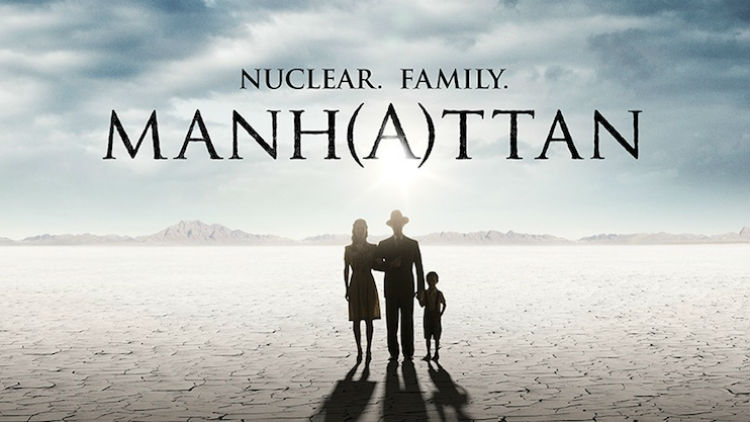A new television show on the Manhattan Project, “Manhattan,” premiered on WGN America on Sunday, July 27 with much fanfare. The Daily Beast proclaimed that the “compelling new period drama” is “quite possibly the best new offering this summer.” The Atomic Heritage Foundation staff and friends gathered to watch the premiere and live-tweeted our responses; check out our Twitter feed here.
“Manhattan” takes place in Los Alamos, NM, opening in July 1943, “766 days before Hiroshima,” and throws the audience right into what will likely be the show’s central tensions: Can they succeed in creating an atomic bomb that will help end the war? Are there spies in their midst? Scientists have to constantly remind each other of just how top-secret the project is, cover for the not-so-innocent indiscretions of their employees, and lie to their increasingly suspicious wives of the true nature of their work.
“Manhattan” hits all the right notes for a historical television drama: love and betrayal, secrecy and spies, and the incessant toll of war. Add in alcohol, the Army, and scientists suffering from nightmares, and Los Alamos becomes a powder keg. While there were certainly many tense moments at Los Alamos during the real Manhattan Project, there were also fun times, from hiking, horseback riding, and escapes to La Fonda in Santa Fe. The only tension reliever “Manhattan” has shown so far is whacking a golf ball into the inky darkness of the desert night. The 1950s-60s historical drama “Mad Men” does a good job of balancing sad and tense moments with funny and happy ones; we will see if the pace of “Manhattan” will provide some relief.
The show is a blend of fact and fiction. The primary characters are entirely fictional including the main scientist, Frank Winter, and a Chinese-American physicist, Sidney Liao. “Manhattan” does portray J. Robert Oppenheimer as the director of the laboratory at Los Alamos. While Oppenheimer could be dismissive to the point of rudeness, “Manhattan’s” first introduction to Oppenheimer seems a little extreme as he ends an argument with Frank Winter by summarily dropping him off in the middle of the New Mexico desert.
Most scientists at Los Alamos were enormously impressed by Oppenheimer’s sheer brilliance and quick grasp of all aspects of the project. As Phil Morrison once said, “We were all completely under his spell. There was no one like him.” Others testify to his kindness including Dimas Chavez, a young Hispanic boy who sold him newspapers. While we understand that “Manhattan” is meant to be a historical drama, not a docudrama, we assume that the show will portray other dimensions of Oppie’s character in future episodes.
It can be difficult for historical purists to watch a show like this, but we enjoyed the first episode of “Manhattan.” If “Manhattan” keeps the historical atmosphere strong and does not succumb to melodrama, it may turn out to be the best new historical drama on television. At the very least, it should help introduce people around the country to the rich and complex history of the Manhattan Project.
We will be live-tweeting all 13 episodes, so be sure to follow us on Twitter for our reactions! We will also post reviews after each episode.





